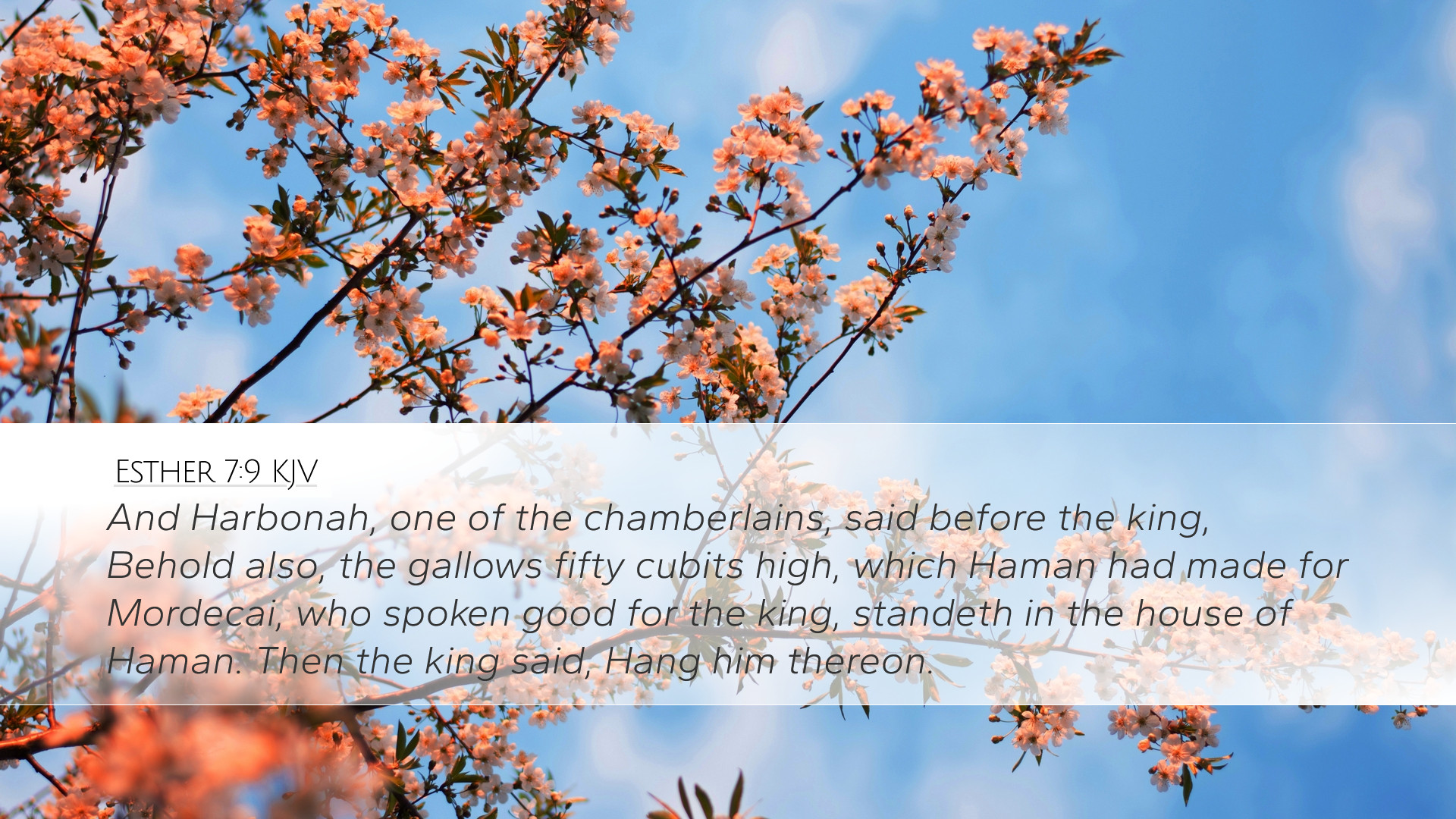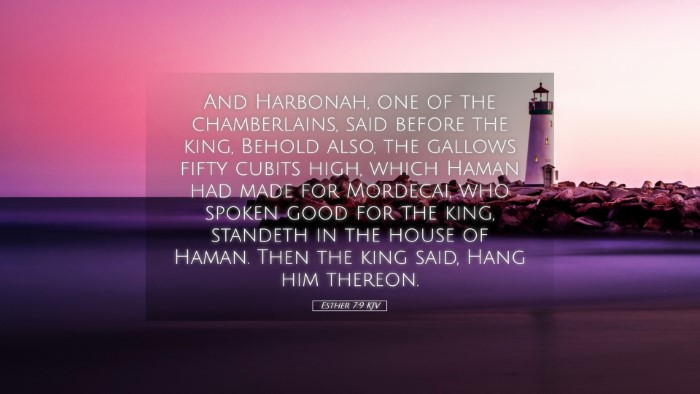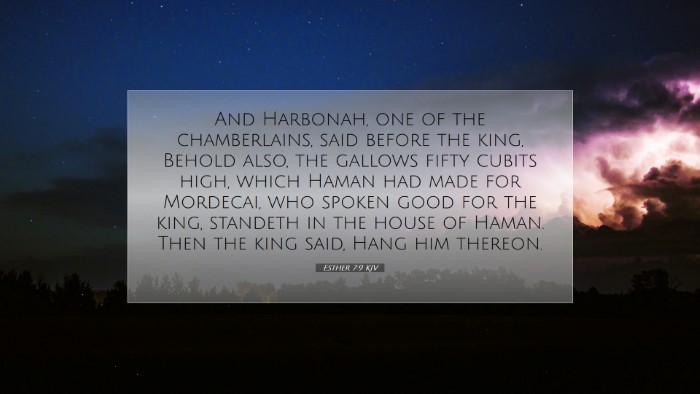Old Testament
Genesis Exodus Leviticus Numbers Deuteronomy Joshua Judges Ruth 1 Samuel 2 Samuel 1 Kings 2 Kings 1 Chronicles 2 Chronicles Ezra Nehemiah Esther Job Psalms Proverbs Ecclesiastes Song of Solomon Isaiah Jeremiah Lamentations Ezekiel Daniel Hosea Joel Amos Obadiah Jonah Micah Nahum Habakkuk Zephaniah Haggai Zechariah MalachiEsther 7:9
Esther 7:9 KJV
And Harbonah, one of the chamberlains, said before the king, Behold also, the gallows fifty cubits high, which Haman had made for Mordecai, who spoken good for the king, standeth in the house of Haman. Then the king said, Hang him thereon.
Esther 7:9 Bible Commentary
Commentary on Esther 7:9
Esther 7:9 states, "And Harbona, one of the eunuchs in attendance on the king, said, 'Moreover, the gallows that Haman has prepared for Mordecai, whose word saved the king, is standing at Haman's house, fifty cubits high.'" This verse serves as a turning point in the narrative of Esther, where the plans of Haman, the antagonist, begin to unravel. Below, we explore the insights from noted public domain commentaries.
Contextual Overview
The context of Esther 7:9 is critical to understanding its theological and moral implications. Haman, having plotted to exterminate the Jewish people, faces the consequences of his actions. Here, Esther's revelatory banquet leads to Haman's exposure and eventual downfall.
Exegesis and Commentary
Nature of Divine Justice
Matthew Henry illustrates the principle of divine justice pervasive throughout Scripture, stating that those who scheme against the innocent often find themselves ensnared by their own devices. Haman's gallows, underscored by Harbona’s timing and presence, highlights the imminent justice that arrives for him.
The Role of Providence
Albert Barnes emphasizes God’s providence in this scenario. Citing the gallows' height, he notes that while Haman intended it for Mordecai, it instead becomes the mechanism of Haman's demise. This switch serves as a vivid illustration of God’s sovereignty and the reversal of fortune that is common in biblical narratives.
The Characters Involved
Adam Clarke draws attention to Harbona’s role, a seemingly minor eunuch who acts decisively at this pivotal moment. His actions remind readers and leaders of the significance of every individual in God’s plan, regardless of their position. Harbona, by pointing out the gallows, illustrates the theme that those who support justice will eventually have a role in exposing injustice.
Thematic Elements
The Nature of True Deliverance
Within this verse, the unfolding narrative emphasizes deliverance born from righteousness rather than the scheming of the wicked. The gallows, a symbol of death, illustrates the stark contrast between Haman’s violent intentions and the providential protection of Mordecai and Esther, culminating in the deliverance of the Jewish people.
Reversal of Fortune
Henry notes the dramatic turn of events - from power to humiliation. The Jews, once under the threat of extermination, are now positioned for deliverance, while Haman—who sought their demise—is sentenced to die on the very instrument he crafted for Mordecai. This thematic reversal serves as a reminder of God’s ability to work through circumstances to fulfill His purposes.
Warnings Against Envy and Malice
Barnes provides a moral assessment, cautioning readers against the destructive nature of envy and malice. Haman’s downfall serves as a solemn warning to those who might harbor ill will and plotting against others. His fate illustrates the inevitable consequences of such actions, reinforcing a call for self-examination and righteousness in one’s dealings with others.
Practical Applications
This commentary on Esther 7:9 is not without rich applications for pastors, theologians, and students of the Word.
- Advocating for Justice: Pastors should champion the cause of the marginalized and oppressed, echoing the spirit of Mordecai and Esther.
- Understanding Providence: The study of Esther encourages believers to recognize and trust in God’s providential hand in their lives and circumstances.
- Encouragement for the Disheartened: The text reassures those who may feel oppressed that justice will ultimately prevail.
- Examination of Character: As Haman’s character is scrutinized, believers are prompted to assess their own hearts, ensuring their actions align with righteousness.
- Promotion of Humility: Harbona’s role reminds leaders of the importance of humility and the value of every contribution in pursuing justice.
Conclusion
Esther 7:9 serves as a powerful reminder of the dynamics of divine justice, the consequences of sin, and the ultimate triumph of righteousness. Through a combined examination of historical context, character studies, and thematic elements, this commentary provides a thorough understanding of the verse's profound implications, urging an engagement with God’s ongoing narrative in the lives of believers.


